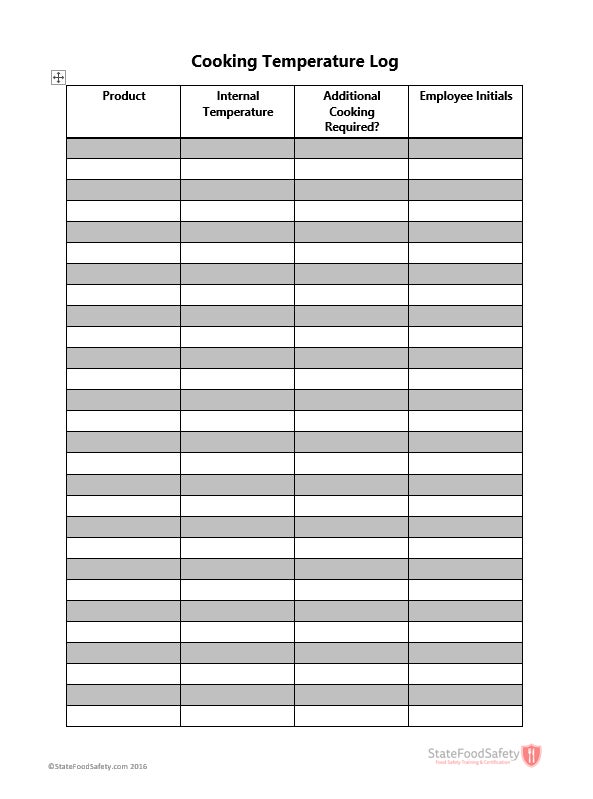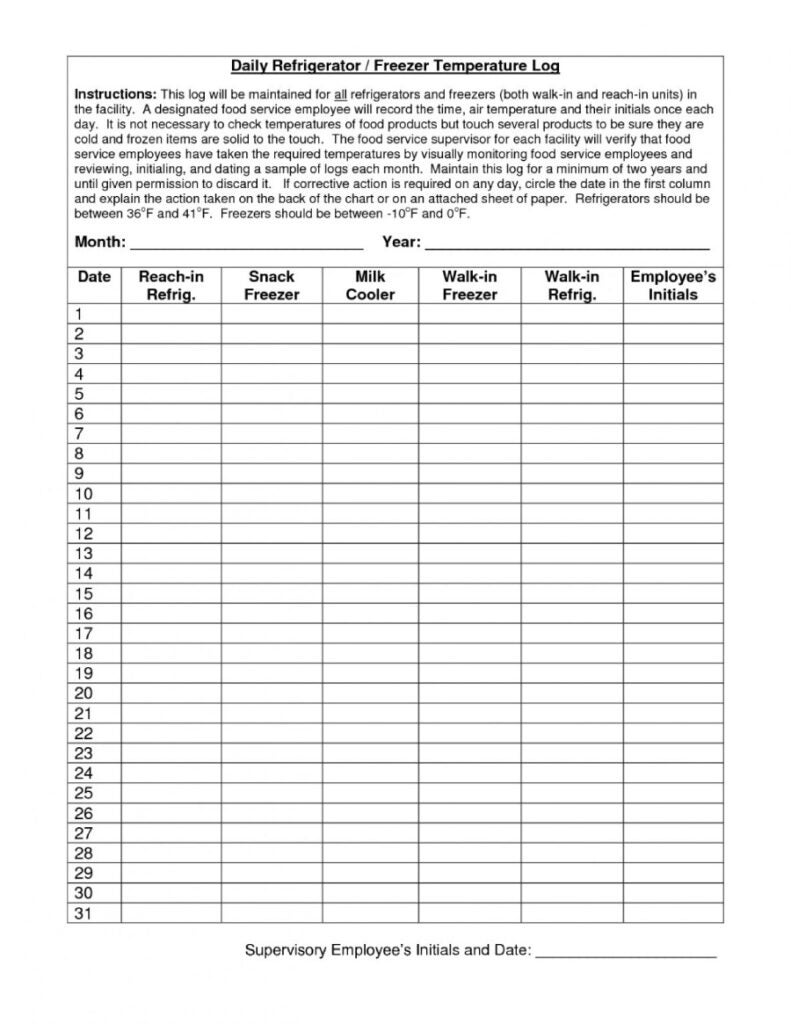Food temperature is one of the key components of keeping the food you serve safe. Proper food temperature storage keeps your items fresh and safe and maintains their flavor. Likewise, knowing the proper cooking temperatures for your food items ensures that what you are serving your customers is safe for consumption and also optimally delicious.
A restaurant is responsible for food temperature management at all points of an ingredient’s lifecycle—from entering the kitchen until serving to the customer. The food temperature chart in this article breaks down key restaurant ingredients and their respective temperature information. Use this chart to determine the proper cooking, storage, and serving temperatures of the food items on your menu.
Food Temperature Chart & Logs
Food temperature is highly important to restaurant operations, and keeping track of temperatures is an important task for restaurant staff. Below is a food temperature chart that breaks down the proper cooking, storing, and serving temperature for specific food items, followed by specific temperature log examples you can use in your kitchen.
Food Temperature Chart
| Food | Cooking Temperature | Storing Temperature | Serving Temperature |
|---|---|---|---|
| Beef, Veal, Lamb | 145F | 40F or below | 145F |
| Ground Meat (Beef, Veal, Lamb) | 160F | 40F or below | 160F |
| Pork (Chops and Roasts) | 145F | 40F or below | 145F |
| Poultry (Chicken, Turkey) | 165F | 40F or below | 165F |
| Pre-cooked Proteins (Ham, Chicken Breasts) | 165F | 40F or below | 165F |
| Fish | 145F | 40F or below | 145F |
| Egg Dishes | 160F | 40F or below | 160F |
| Leftovers | 165F | 40F or below | 165F |
| Salads or Fresh Produce | N/A | 40F or below | 40F or below |
The logs below are great ways to check and ensure that proper food temperature is hit and accounted for.
The hot food log records temperature over two hours, ensuring the food does not sit in the Danger Zone for too long.

The cold food log monitors temperatures through a shift, and if one is out of temp, then action must be taken and recorded.

The cooking log helps you ensure that proteins and other dishes are cooked to the required temperatures, with a sign-off by the cook for accountability tracking.

This log can be used for specific types of refrigerators and freezers, including reach-in and walk-in refrigerators, milk coolers, and snack freezers.

The Danger Zone
The food temperature “danger zone” is a temperature range in which foodborne bacteria grow rapidly in perishable food items. The range of this zone is 40F to 140F. It is imperative to keep perishable foods out of the danger zone so they are safe for consumption.
After a certain period in the temperature range of the danger zone, food must be discarded. For example, the time limit for refrigerated or perishable foods to be in the temperature danger zone is two hours. Below are some tips to keep foods out of the temperature danger zone.
- Keep refrigerated foods cold: Keeping perishable foods that are cold, such as raw protein or vegetables, below 40F is key. Using refrigerators, ice packs, or ice baths is how you can keep these items out of the temperature danger zone.
- Keep hot foods hot: For hot foods, ensuring once they have reached their proper cooking temperatures to keep them above 140F is the goal. This can be done using chafing dishes, warming trays, or other heated food storage equipment.
- Cool foods properly: When cooling down cooked items, use shallow containers and cold environments when cooling them down. For example, pour sauces or soups into thin hotel pans to cool in the fridge to get them out of the danger zone as soon as possible.
- Reheat to 165F: Reheating leftovers or other food products to 165F ensures all bacteria are killed and food is safe to consume. Please note that reheating does not negate food that has been temperature abused. If your food has been left in the danger zone for too long, it cannot be consumed, even if reheated properly.
- Thaw properly: Thawing foods in the fridge, under cold running water, or in the microwave are all ways to ensure that they do not spoil in the danger zone. Never leave food at room temp or in stagnant water to thaw.
Why Is Food Temperature Important in Restaurants?
Managing food temperature is one of the key pillars of food safety. Below are the key reasons why maintaining proper food temperature is so important.
- Prevents foodborne illness: Ensuring food is stored and served at the right temperature reduces the risk of foodborne illness greatly, making eating at your restaurant a safe experience.
- Ensures food safety: Proper temperature control also ensures that food is safe to consume at all of the stages it presents itself in a restaurant.
- Improves food quality: Serving food at the correct temperature is also beneficial to flavor. Food served at its optimal temperature brings the best flavor and eating experience to the customer.
- Reduces waste: When you store and serve food at the proper temperature, you prevent spoilage. Preventing food from going bad reduces waste and saves the business money.
- Adheres to local compliance: The Health Department requires proper food storage in order to operate as a food business. Food temperature is not only a key feature for good products but is also integral to keeping your restaurant in good standing.
- Maintains reputation: When restaurants consistently serve safe, delicious food, they gain stellar reputations. When temperatures are controlled, your staff can focus on dining experiences that make customers rave about your product.
- Stresses food safety: When you run a kitchen with strict adherence to food temperature safety, your staff is diligent in how they handle and prepare food items. This leads to an environment where food safety is paramount and held in high regard.
Maintaining proper food temperatures is the bedrock of safe, delicious food. Customers rely on you to keep your food safe, so understanding how temperature affects all your ingredients is a must for any chef or cook. Restaurants that prioritize proper food handling gain the reputation of reliable food businesses. In turn, this is how you grow your customer base and become a staple in the local food scene.
Best Practices for Food Safety
As a food business, it is your duty and responsibility to serve food that is safe to consume. The last thing a customer should worry about is if the food they are about to pay for will get them sick. Below are some best practices for managing food safety in your restaurant.
Stress Personal Hygiene
Items such as clean aprons and chef coats, aprons, and side towels should always be maintained in your kitchen. Hand-washing sinks with full soap dispensers and paper towels must be stocked.
Training your staff on when to wash their hands after handling different products, proper handwashing times, when to wear gloves, and how often they should change gloves are all key details in food safety. Furthermore, setting the standard for clean uniforms, having dedicated break areas, and being diligent in personal cleanliness are all ways to ensure good hygiene in the kitchen.
Train Staff on Proper Food Storage & Cooking Temps
Training staff on how to store foods, especially perishable items, is important to ensure the quality and safety of your products.
Furthermore, teaching your staff how to take food temperatures, calibrate thermometers properly, and determine the required cook temperatures for different products will ensure a safe food environment. Establishing systems such as first in, first out (FIFO), regular handwashing intervals, and consistent temperature checks are all steps you can take to keep food safe.
Follow Proper Cleaning & Sanitizing Procedures
Keeping your kitchen clean is essential to creating an environment where food can be prepared safely. Maintaining cleaning logs, establishing cleaning schedules, and assigning roles for each section of the kitchen are fundamental in tracking the cleanliness of your space.
Additionally, ensuring your dishwasher is running at the right temperature, your sanitizer solution is strong enough, and all other cleaning equipment is functional is the manager’s responsibility in keeping a restaurant kitchen clean. Teaching your staff how to prevent cross-contamination is another key aspect of proper cleaning and sanitizing.
Don’t Neglect Pest Control
Pests are a constant battle in restaurants—one you can lose if you are not diligent. Pest control starts with keeping your kitchen as clean as possible. A dirty kitchen attracts pests, so keeping it clean is vital to keeping them out. Hiring professional pest control personnel to conduct regular inspections, seal entry points, and proactively keep pests out is another great way to control pests. Pests can truly damage a restaurant’s reputation, so ensuring your pest control program is robust is vital.
Conduct Proper Monitoring & Record-Keeping
Temperature logs are a great way to prevent food from staying in the temperature danger zone. Keep temp logs when you receive highly perishable items such as whole fish and shellfish tags after receiving items such as fresh oysters. Documentation and systems that catch temperature discrepancies are the key ways to ensure the food you are saving has not been temperature abused.
Frequently Asked Questions (FAQs)
Below are some of the most commonly asked questions regarding food temperature management in professional kitchens.
Last Bite
Food temperature is a vital aspect of cooking, food safety, and restaurant operations. It cannot be overstated how much attention and detail must be paid to food temperature in a restaurant operation. If food temperature is not monitored or maintained, your food can cause customers to become sick, and your business’s reputation will be in jeopardy. Use the charts, logs, and advice in this article to follow proper food temperature management in your restaurant.
ALSO READ



